Paint Thinners and Additives 4CR
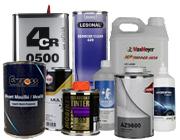
4CR professional paint thinners
-
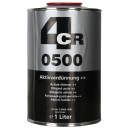 0500.1000Active ThinnerFast - 1L
0500.1000Active ThinnerFast - 1L -
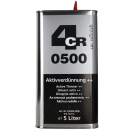 0500.5000Active ThinnerFast - 5L
0500.5000Active ThinnerFast - 5L -
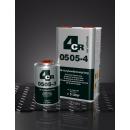 0505.10002K acrylic ThinnerStandard - 1L
0505.10002K acrylic ThinnerStandard - 1L -
 0505.10012K acrylic ThinnerSlow - 1L
0505.10012K acrylic ThinnerSlow - 1L -
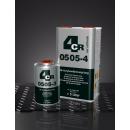 0505.50002K acrylic ThinnerStandard - 5L
0505.50002K acrylic ThinnerStandard - 5L -
 0505.50012K acrylic ThinnerSlow - 5L
0505.50012K acrylic ThinnerSlow - 5L -
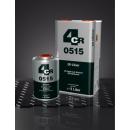 0515.10002K Joining Thinner1L
0515.10002K Joining Thinner1L -
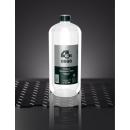 0660.1000Demineralised water1L
0660.1000Demineralised water1L -
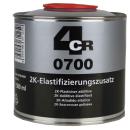 0700.05002K elasticizing Additive0,5L
0700.05002K elasticizing Additive0,5L
︾
4CR: presentation of paint thinners and bodywork additives
The use of paint thinners and bodywork additives depends on the specific product you're using, the type of paint and the results you want to achieve. However, here's a general guide on how to use these products:
Using Paint Thinners:
Preparing the surface:
Make sure the bodywork surface is clean, dry and degreased before applying paint.
Choice of Paint Thinner :
Select the right Thinner for the type of Paint you are using. Consult the manufacturer's recommendations for the recommended Thinner.
Measuring accurately:
Measure the amount of Thinner needed according to the Mixing ratios recommended by the manufacturer. Use appropriate measuring tools.
Mixing:
Thoroughly mix the Thinner with the Paint. Use a stirrer or paint mixer to ensure even distribution.
Viscosity test:
Perform a viscosity test to ensure the paint is at the desired consistency. Add Thinner if necessary.
Application:
Apply the thinned paint to the bodywork using the method of your choice (spray, brush, etc.). Follow the appropriate techniques to obtain an even coat.
Using car additives:
Selecting the car additive:
Choose the Additive according to the results you want to achieve. Some additives can improve gloss, scratch resistance or other characteristics.
Appropriate quantity:
Measure the amount of Additive recommended by the manufacturer according to the volume of paint you are using.
Mixing:
Mix the Additive with the paint in the same way as the Thinner. Make sure you get an even distribution.
Application:
Apply the paint with the Additive as you normally would. Follow the recommended drying times.
Finishing and protection:
Some Additives may require an additional finishing step, such as the application of a protective Clearcoat.
Always follow the manufacturer's specific instructions on the packaging of thinners, additives and paints. Wear personal protective equipment, including a mask, gloves and goggles, as recommended by the manufacturer. Work in a well-ventilated area to avoid inhaling harmful vapours.
Clean all tools thoroughly after use, following the manufacturer's recommendations for the appropriate solvents. These steps provide a general overview. It is crucial to refer to the manufacturer's specific instructions for optimum results.
The different types of 4CR brand Paint Thinner :
The different types of paint thinners, such as 2K acrylic thinner, active paint thinner, and two-coat paint thinner, are designed for specific applications and vary according to the paint systems used. Here is an explanation of each of these Thinners:
2K Acrylic Thinner :
Paint type : 2K acrylic Thinner is specifically formulated for use with 2K acrylic paints, which are two-component paints (comprising a base paint and a Hardener).
Purpose : It is used to adjust the viscosity of 2K acrylic paint, making it easier to apply using spray guns or other methods.
Characteristics: 2K acrylic thinners are often designed to interact specifically with the 2K system, ensuring correct polymerisation and a durable finish.
Active Paint Thinner :
General Purpose: The term "Active Thinner Paint " can be used generically to describe a thinner used to adjust the viscosity of various types of paints.
Variable characteristics: Specific characteristics may vary according to formulation and manufacturer. Some active Thinners can be used with water-based or solvent-based paints.
Two-coat Paint Thinner :
Paint type: Two-coat Paint Thinner is generally intended for use with two-coat paint systems, which include a Basecoat and a Clearcoat.
Function: It helps to adjust the viscosity of the two-coat paint for even application of the Basecoat and Clearcoat.
Compatibility: These Thinners are formulated to be compatible with the different stages of the two-coat paint process, helping to achieve an attractive, protective finish.
It is important to note that exact specifications may vary from brand to brand, and it is always advisable to follow the manufacturer's specific recommendations for each product. The instructions on the packaging of Paint Thinners provide valuable information on mixing ratios, drying times and other important considerations for achieving optimum results.
All you need to know about using paint thinners and bodywork additives :
The types of paint Thinner frequently raise questions among users, whether they are seasoned bodywork professionals or passionate tuning enthusiasts. These questions, which are often recurrent, reflect a constant concern to achieve an impeccable, long-lasting finish during car paint projects. Let's take a look at some of the most frequently asked questions, and their explanatory answers:
What is the main role of a paint thinner?
The central role of a paint Thinner is to adjust the viscosity of the paint, allowing it to be applied smoothly and evenly to the bodywork surface. This makes it easier to create an aesthetically pleasing finish.
What's the difference between a 2K acrylic paint thinner and a two-coat paint thinner?
The differences lie in the paint systems for which they are intended. The 2K acrylic thinner is specific to two-component paints, while the two-coat paint thinner is designed for systems comprising a basecoat and a clearcoat.
Can any Thinner be used with any type of Paint?
It's essential to choose the right Thinner for the type of paint you're using. Manufacturers provide specific recommendations to ensure compatibility and optimise results.
How do I choose the right Thinner for my Paint?
Thinner selection depends on the type of Paint, the application conditions and the desired results. Referring to the manufacturer's recommendations and, if necessary, consulting experienced professionals can help you make the right choice.
What are the risks of using Thinners incorrectly?
Incorrect use of Paint Thinners can lead to problems such as drips, inappropriate drying times and changes in the quality of the finish. It is vital to follow the manufacturer's instructions.
Do I need to thin my paint with each coat?
The need to thin paint depends on the type of paint, atmospheric conditions and the desired result. We recommend that you follow the manufacturer's recommendations for each coat.
How can I avoid drips when using Thinner Paint?
Avoiding drips involves careful application, precise mixing and appropriate adjustment of viscosity. Following application techniques and the manufacturer's advice will minimise the risk of drips.
What are the benefits of using Additives in addition to Thinners?
Bodywork additives offer additional benefits such as improving resistance, adding shine or customising the finish. The choice of additives depends on the specific needs of the project.
These answers shed light on some of the questions most frequently asked by users, illustrating their constant quest for understanding and excellence in the field of automotive paint.